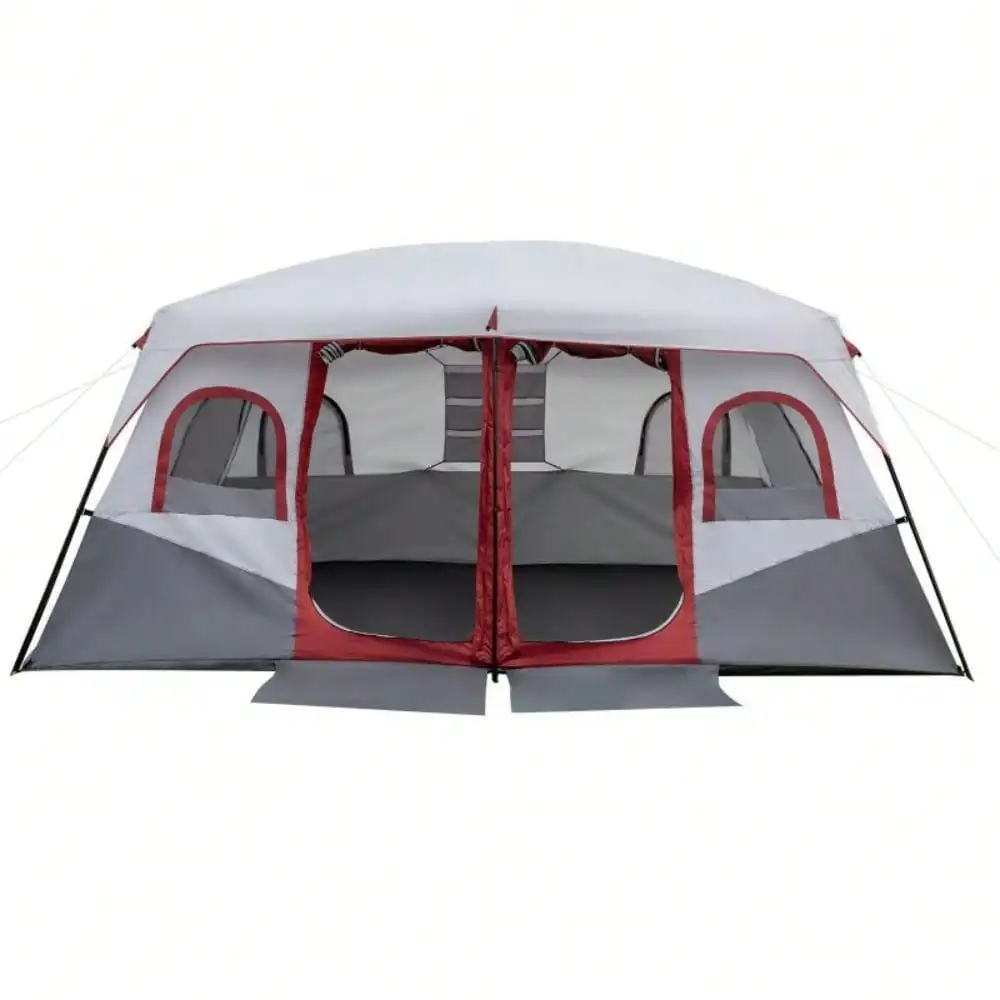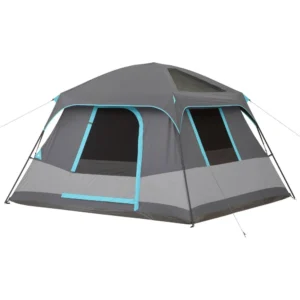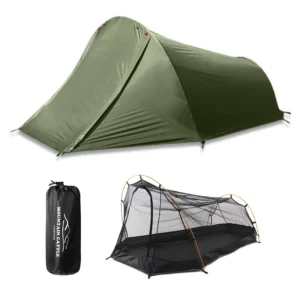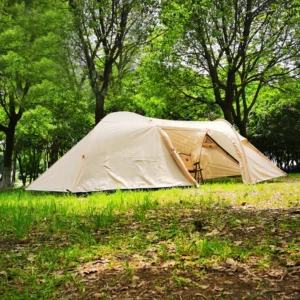Why Canvas Tents Excel for Extended Outdoor Living
Canvas tents stand apart as the premier choice for those seeking a long-term outdoor living solution. Unlike synthetic alternatives, these time-tested shelters offer unique qualities that create a true home in the wilderness.
The remarkable breathability of canvas creates a healthier living environment than synthetic materials ever could. Canvas naturally exchanges air while maintaining protection, significantly reducing condensation that can lead to dampness and discomfort. This natural ventilation is why many extended-stay campers report waking up dry and comfortable after weeks in canvas shelters for rugged camping, while synthetic tent users often contend with morning moisture.
One of canvas’s most impressive qualities is its natural insulation properties. Quality canvas material typically maintains temperatures 15-20°F cooler in summer heat and noticeably warmer during cold seasons by trapping body heat more effectively than synthetic fabrics. This temperature regulation becomes increasingly valuable the longer you stay outdoors.
When considering longevity, the difference becomes even more striking. While quality synthetic tents might last 2-5 years with regular use, properly maintained canvas shelters commonly serve for 10-15 years or more, making them significantly more economical for long-term use. The reasons to choose canvas tents extend beyond mere durability:
- Superior sound dampening from rain and wind
- Natural feel and aesthetic that connects with surroundings
- Easier field repairs with simple sewing techniques
- Better resistance to sparks from nearby campfires
- Enhanced ability to withstand snow loads
Furthermore, canvas creates a noticeably different sensory experience than the plastic-like environment of canvas vs nylon tents. The material breathes silently in the wind rather than flapping noisily, absorbs sound rather than amplifying it, and provides a more natural, home-like atmosphere that becomes increasingly important during extended stays.
Best Canvas Tent Styles for Extended Living
Selecting the right canvas shelter style dramatically impacts your long-term comfort. Each design offers distinct advantages depending on your needs and location.
Wall Tents
The rectangular design and vertical walls of these tents maximize usable interior space, making them ideal for extended living. Typical dimensions range from 10×12 feet to 16×20 feet (3×3.6 meters to 4.9×6.1 meters), providing ample room for furniture, equipment, and comfortable movement. The frame construction, usually aluminum or steel, creates exceptional stability for all-weather conditions. For those settling in one location for weeks or months, wall tents offer the most home-like interior among canvas options.
The vertical sidewalls allow for efficient space usage right to the edges of the tent, unlike designs where sloping walls reduce usable area. This feature becomes increasingly valuable when organizing a functional living space for the long term. Many heavy-duty canvas shelters in this style also include stove jacks for heating, which is essential for extended cold-weather stays.
Bell Tents
For those who value quick setup and aesthetic appeal, bell tents provide an excellent alternative. Their cone-shaped design with a central pole creates surprising interior space efficiency while maintaining excellent stability in varying conditions. Most bell tents feature a circular floor plan ranging from 13-20 feet (4-6 meters) in diameter, with center heights of 8-10 feet (2.4-3 meters).
The simplicity of the center pole design also means fewer components to manage or potentially break during long-term use. Many modern bell tents incorporate additional features specifically for extended living, such as removable floors, integrated stove jacks, and modular wall systems that can be rolled up for ventilation.
Cabin Tents
For family groups or those requiring dedicated spaces for different activities, cabin-style canvas tents offer multi-room configurations with dividers and sometimes multiple entrances. These designs typically provide the most home-like interior arrangements with near-vertical walls and often feature ridge heights allowing full standing throughout.
The separated spaces within cabin tents allow for dedicated sleeping, dining, and equipment storage areas – a valuable feature for maintaining organization during extended stays. Many canvas camping tent options in this style feature reinforced frameworks specifically designed to withstand continuous use and varied weather conditions.
When selecting for long-term use, consider the following key factors regardless of tent style:
* Floor space needs based on occupants and equipment
* Height clearance throughout the living area, not just center height
* Frame material durability (powder-coated steel offers maximum longevity)
* Canvas weight (12-15oz provides optimal durability without excessive weight)
* Seasonal adaptability features (removable floors, multiple ventilation options)
Selecting and Preparing Your Long-Term Campsite
Finding the perfect location for your canvas home is arguably as important as the tent itself. The ideal site combines practical considerations with legal compliance and comfort factors.
Start by evaluating drainage patterns – even slight slopes of 1-2% away from your tent area can prevent devastating water issues during heavy rainfall. Look for natural landscape features that create wind barriers while ensuring you’re not in a potential flood zone. Southern exposure provides maximum natural light and solar heating potential in cooler months.
Legal considerations cannot be overlooked when planning extended stays:
* Research land use regulations for your chosen area
* Secure necessary permits (some public lands limit stays to 14-30 days)
* Understand seasonal closures or restrictions
* Consider private land options with appropriate permissions
Ground preparation becomes critical for extended comfort. Clear a footprint area at least 2 feet (60 cm) larger than your tent dimensions on all sides. Remove all sharp objects, roots, and rocks that could damage your tent floor and create sleeping discomfort. For truly extended stays, consider installing a proper foundation:
- Wooden platforms: Create level, elevated surfaces that improve drainage, insulation, and floor durability
- Gravel pads: Provide drainage and pest barriers, though less comfortable underfoot
- Composite decking: Offers durability and moisture resistance for semi-permanent installations
Pay special attention to safety factors when selecting your site. Maintain at least 20 feet (6 meters) distance from dead trees, avoid camping directly under large branches, and stay away from game trails and natural wildlife corridors. The canvas tent setup guide provides additional insights on positioning for maximum safety and convenience.
Remember that sites that seem acceptable for weekend camping often reveal serious flaws during extended stays. Take time to observe potential areas during different weather conditions if possible before committing to a location. Well-chosen sites make heavy-duty 4-season tents perform at their best potential by minimizing environmental stressors.
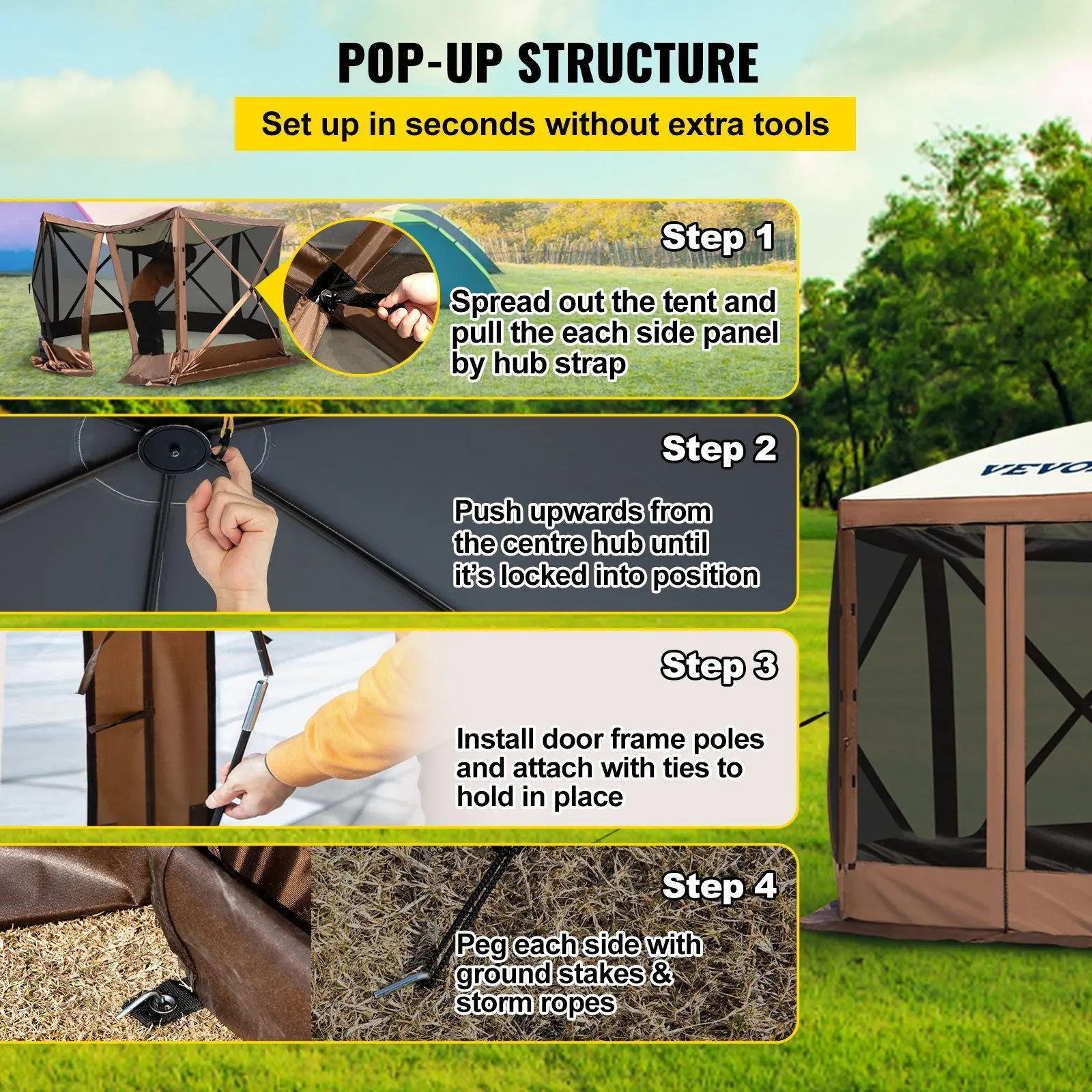
Setting Up Your Canvas Home for Maximum Stability
Properly setting up your canvas tent for long-term use requires more attention to detail than weekend camping. The investment in proper setup pays dividends through enhanced durability and comfort throughout your stay.
Begin with frame assembly following the manufacturer’s instructions precisely. For extended use, consider reinforcing connection points with additional hardware or backup cordage. Canvas tension is critical – too loose and you’ll experience sagging and water pooling; too tight and you risk stressing seams and zippers over time. Most canvas tents benefit from initial moderate tensioning followed by adjustments after the fabric settles.
Strategic guy line placement dramatically improves weather resistance and durability. For long-term stability:
* Install guy lines at all provided attachment points, not just corners
* Use heavy-duty stakes 12-18 inches (30-45 cm) in length
* Angle stakes away from the tent at 45° for maximum holding power
* Consider installing “storm lines” across the roof for high-wind situations
For semi-permanent installations, additional reinforcement methods provide insurance against extreme weather:
1. Supplementary external guy lines attached to trees or ground anchors
2. Internal support poles or adjustable braces for snow load management
3. Perimeter trenching for water diversion (where permitted)
4. Wind barriers using natural features or temporary screening
Optimizing your tent’s orientation based on local conditions significantly enhances comfort. Position doorways away from prevailing winds to minimize heat loss and dust infiltration. In hot climates, orient to capture cross breezes through windows and vents. Winter camping tents benefit from positioning that maximizes morning sun exposure while offering afternoon shade.
For truly extended stays, establish a weekly maintenance routine to check and adjust tension, inspect guy lines for wear, and verify stake placement has not shifted. This preventative approach prevents small issues from developing into structural failures that could compromise your shelter.
Creating a Comfortable Living Space Inside Your Canvas Tent
Transforming your canvas shelter into a functional living space requires thoughtful organization and appropriate furnishings. The key is maximizing comfort while respecting the unique constraints of tent living.
Begin by implementing clear interior zones for different activities:
* Sleeping area positioned away from entrance to minimize drafts and disturbance
* Living/relaxation space situated near natural light sources
* Cooking/eating zone with easy access to entrance (for ventilation and supply transfer)
* Storage areas organized by frequency of use, with daily items most accessible
Flooring deserves special attention for long-term comfort. Start with a heavy-duty groundsheet extending slightly up the walls to prevent moisture ingress. Layer options include:
* Closed-cell foam mats for insulation and cushioning
* Interlocking foam tiles for cleanliness and comfort
* Low-pile outdoor rugs for homey atmosphere
* Raised wooden platforms in high-traffic areas
Furniture selection must balance comfort with practicality. Collapsible options conserve space when not in use while providing full functionality when deployed. Consider weight limits for your tent floor system—typically 30-50 pounds per square foot (145-245 kg per square meter) for platform floors. Multi-functional pieces serve dual purposes, such as storage trunks that double as seating or tables that convert to desks.
Vertical space utilization becomes essential in maximizing your living area. Suspend lightweight items from frame elements using carabiners or hooks. Install tension rods between frame supports for hanging clothes or towels. Two-room camping tents offer natural division for different activities or occupants, enhancing privacy and organization.
For multi-person occupancy, create visual privacy with fabric room dividers, strategic furniture placement, or designated changing areas. Sound privacy improves with soft goods like rugs and fabric wall hangings that absorb ambient noise.
The importance of headroom cannot be overstated for long-term comfort. Tents with full-height doors and adequate standing space prevent the physical and psychological strain of constant stooping, especially important during extended stays.
Mastering Temperature Control in All Seasons
Managing your canvas home’s internal climate becomes a daily priority during long-term stays. Canvas offers excellent temperature regulation capabilities, but maximizing comfort requires active management strategies tailored to each season.
Cold Weather Strategies
Wood stoves represent the gold standard for heating canvas tents, providing efficient warmth and a pleasant ambiance. Safe installation requires:
* Proper stove jack installation with heat-resistant material
* Maintaining minimum clearances of 18-24 inches (45-60 cm) from all canvas surfaces
* Spark arrestor on chimney and fire-resistant floor protection
* Carbon monoxide detector as mandatory safety equipment
Beyond heating sources, insulation dramatically improves efficiency. Insulated canvas shelters incorporate these techniques:
* Wool blankets hung as internal wall liners trap air and create dead space
* Foam padding under floor coverings reduces ground chill
* Reflective emergency blankets positioned behind heat sources direct warmth inward
* Entrance vestibules or flaps minimize heat loss during entry/exit
Draft prevention becomes crucial in maintaining comfortable temperatures. Seal gaps around door openings with additional fabric flaps or weatherstripping. Use fabric door snakes at floor level to block cold air infiltration. During extreme conditions, temporarily reduce your living space by closing off unused portions with hanging dividers to create smaller, more easily heated areas.
Warm Weather Approaches
Canvas’s natural breathability gives it advantages in hot weather, but additional strategies enhance comfort:
* Configure all available ventilation options – windows, doors, wall roll-ups
* Position portable fans to create cross-flow through the tent
* Install shade awnings over sun-exposed walls and roof sections
* Use light-colored external tarps to reflect solar radiation
* Temporarily remove side walls during day while maintaining roof protection
Cold weather camping tent comparisons often highlight features equally valuable in managing summer heat, such as multiple ventilation points and adjustable wall systems.
Year-Round Moisture Management
Controlling humidity remains essential regardless of season. In winter, balance ventilation with heat retention to prevent condensation from indoor activities and respiration. In summer, maximize air movement to evaporate moisture. Always maintain ground-level ventilation options to release humid air that naturally settles toward the floor.
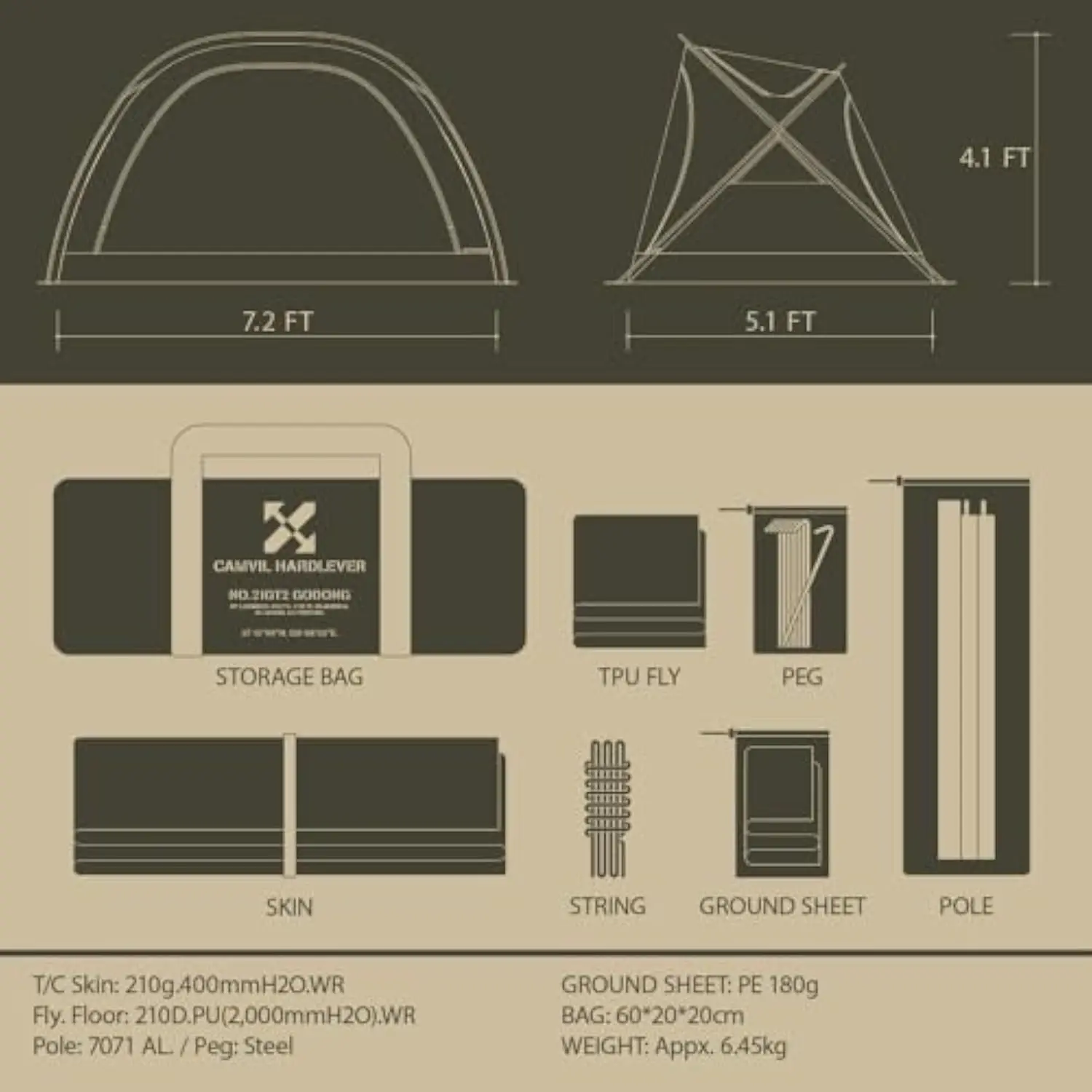
Essential Canvas Tent Maintenance for Longevity
Consistent maintenance transforms your canvas tent from a temporary shelter to a durable long-term home. Following a structured care routine significantly extends your tent’s serviceable life.
The maintenance journey begins before your first night’s stay through proper seasoning of new canvas. This critical process involves:
1. Setting up the tent before extended use
2. Allowing it to get thoroughly wet naturally through rain or light hosing
3. Permitting complete drying in position to allow fabric fibers to swell and shrink
4. Repeating this process 2-3 times to tighten weave naturally
Regular cleaning prevents degradation of both waterproofing treatments and the canvas itself. Use gentle techniques:
* Brush loose dirt and debris with soft-bristled brooms
* Spot clean with mild, non-detergent soap solutions
* Avoid harsh chemicals or bleach products that damage waterproofing
* Rinse thoroughly without high-pressure spraying
Mold and mildew represent the greatest threats to canvas longevity. Prevention includes:
* Never packing or storing damp canvas
* Maintaining ventilation even during adverse weather
* Applying anti-mildew treatments appropriate for canvas (typically containing enzymes rather than harsh chemicals)
* Immediate attention to any visible mildew using vinegar-water solutions (1:5 ratio)
Waterproofing maintenance becomes necessary as natural weather exposure reduces water resistance. Most canvas tents require retreatment every 1-2 years, though inspection should dictate timing. Select canvas-specific waterproofing products rather than general outdoor fabric treatments. Complete canvas tent care involves applying treatments evenly, paying special attention to seams and high-wear areas.
UV protection represents another critical maintenance aspect. Canvas naturally resists UV better than synthetics, but prolonged exposure eventually causes degradation. Minimize direct exposure when possible and apply UV-resistant treatments designed for canvas materials annually.
Develop familiarity with basic canvas repair techniques for field maintenance:
* Keep appropriate needle and waxed thread for stitch repairs
* Use canvas-specific patch materials for tears
* Maintain seam sealer for waterproofing repairs
* Address small issues immediately before they expand
Understanding tent waterproof ratings helps you monitor your canvas home’s performance and anticipate maintenance needs before leaks develop.
Critical Gear for Long-Term Canvas Tent Living
Extended canvas tent living requires specialized equipment beyond basic camping gear. Strategic investments in these key categories significantly enhance comfort and convenience.
Enhanced Anchoring Systems
Standard tent stakes prove insufficient for lengthy deployments. Upgrade to:
* 12-18 inch (30-45 cm) spiral or screw-type anchors for sandy or loose soil
* Heavy-duty V-shaped or Y-stakes for normal ground conditions
* Specialized rock or snow anchors for challenging terrain
* Supplemental guy line systems with adjustable tensioners
Optimized Sleeping Systems
Quality sleep becomes increasingly important during extended stays:
* Full-height cots or platform beds minimize ground chill and enhance organization
* Mattress systems with multiple components for seasonal adjustment
* Bedding appropriate to expected temperature ranges rather than just sleeping bags
* Moisture barriers between sleeping surfaces and ground or tent floor
Heating Solutions
Safe, efficient heating transforms cold-weather canvas living:
* Small wood stoves with appropriate safety features and proper installation
* Propane heaters with tip-over protection and oxygen depletion sensors
* Heat-resistant floor protectors extending at least 24 inches (60 cm) from heat sources
* Fuel storage systems appropriate to heating method and duration of stay
Lighting Systems
Extend usable hours while minimizing battery consumption:
* Solar-charged LED systems with multiple brightness settings
* Mix of ambient and task lighting for different activities
* Motion-activated options for entry areas and nighttime convenience
* Backup lighting solutions using different power sources
Water Management
Develop systems for collection, storage, and conservation:
* Rain collection systems compatible with tent design
* Portable filtration appropriate to local water sources
* Collapsible storage containers with appropriate capacity for group size
* Gray water management appropriate to local regulations
Power Options
Even modest electrical capacity dramatically improves comfort:
* Solar panel systems sized to core requirements (typically 100-200 watts)
* Battery banks with capacity for 3-5 days without charging
* Efficient device charging stations minimizing conversion losses
* Power conservation practices and schedules
For those seeking the most comfortable options for extended stays, 4-season winter 2-person tents often include additional features like reinforced frames and multiple ventilation options that prove invaluable during long-term use.
Tall / Stand Up Camping Tent, Two Room Camping Tent
$407.93 Select options This product has multiple variants. The options may be chosen on the product pageHeavy Duty 4 Season Tent, Mountaineering Tent, Winter Camping Tent
$870.40 Select options This product has multiple variants. The options may be chosen on the product pageCompact Backpacking Tent, Lightweight Backpacking Tent, Waterproof Camping Tent
$335.52 Select options This product has multiple variants. The options may be chosen on the product pageUltralight Backpacking Tent, Ultralight Dome Tent, Winter Camping Tent
Price range: $369.63 through $370.07 Select options This product has multiple variants. The options may be chosen on the product pageCamping Tent with Vestibule, Waterproof Camping Tent
Price range: $407.89 through $479.48 Select options This product has multiple variants. The options may be chosen on the product pageHeavy Duty 4 Season Tent, Ultralight Freestanding Tent, Winter Camping Tent
$3,722.66 Select options This product has multiple variants. The options may be chosen on the product page
The essential features of winter hiking shelters often translate directly to requirements for comfortable extended stays, particularly regarding insulation and moisture management capabilities.
Overcoming Common Challenges of Long-Term Canvas Dwelling
Extended canvas living inevitably presents unique challenges. Understanding and preparing for these common issues transforms potential problems into manageable situations.
Humidity management becomes a daily consideration rather than a weekend inconvenience. Combat excessive moisture by:
* Establishing cross-ventilation patterns appropriate to weather conditions
* Using desiccants like silica gel in enclosed storage areas
* Creating “dry rooms” within your tent for moisture-sensitive gear
* Regularly rotating bedding and fabrics for airing and drying
Wildlife and pest management takes on greater importance during extended stays:
* Establish strict food handling protocols with nothing left accessible
* Create separate cooking areas distanced from sleeping quarters
* Install fine mesh screening over ventilation areas
* Maintain tidy surroundings with regular perimeter maintenance
Extreme weather preparations should include contingency plans for each season:
* Snow load management through regular clearing and internal supports
* High wind protocols including additional anchoring and protective positioning
* Heavy rain response with drainage channel maintenance and equipment elevation
* Excessive heat management through temporary shade structures and ventilation maximization
Privacy and security considerations for times you’re away from camp:
* Develop relationships with nearby campers for mutual monitoring
* Use simple deterrents like closed flaps and subtle personal property concealment
* Consider portable lock systems for zippers and entries
* Avoid displaying valuable equipment unnecessarily
Canvas shelter durability becomes increasingly important as stays lengthen, with small weaknesses potentially developing into significant problems over time. Regular inspection routines focusing on high-stress areas help identify issues before they compromise your shelter.
The psychological adjustments to compact living spaces represent an often overlooked challenge. Create visual expansiveness through strategic organization, establish private zones even in shared spaces, and develop routines for solitude even in communal settings. Many experienced tent dwellers recommend navigation strategies for nature’s fury that address both physical and mental preparation for extended outdoor living.
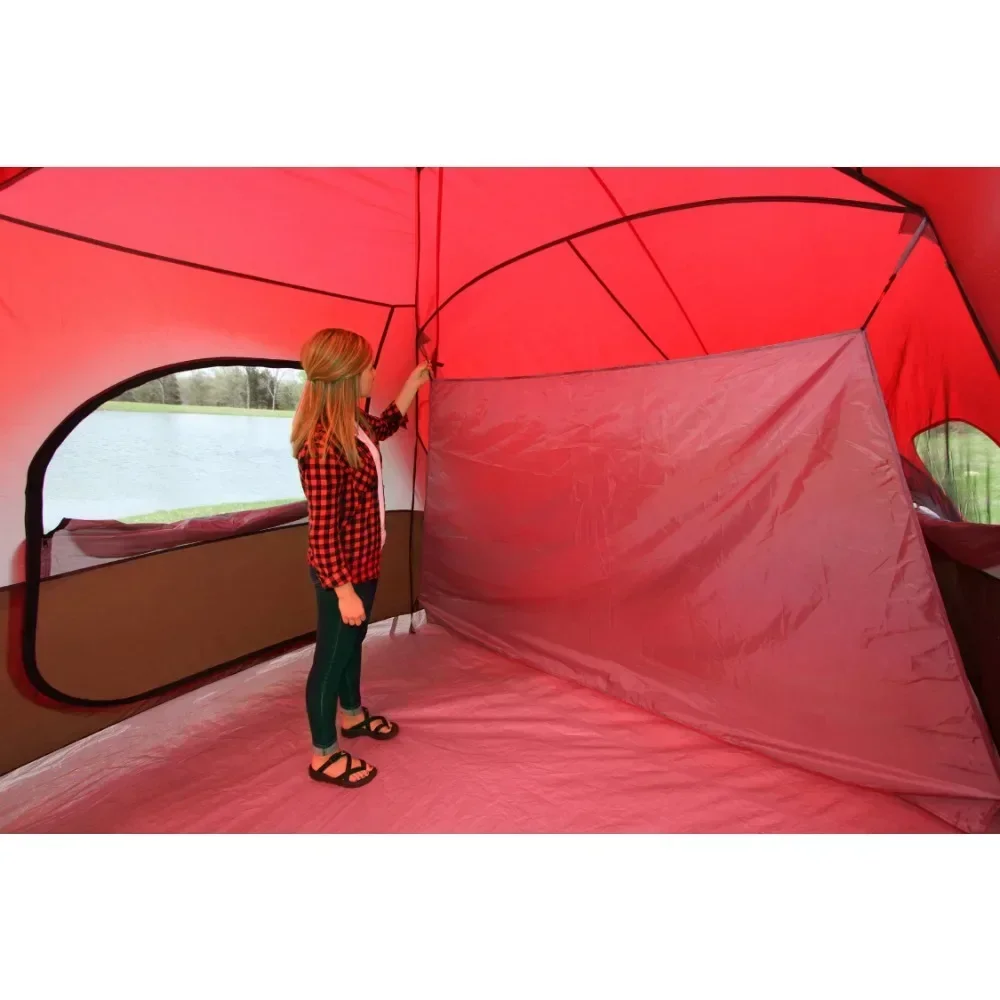
Expert Tips from Seasoned Canvas Tent Dwellers
Those who have embraced canvas tent living for extended periods offer invaluable insights beyond basic guides and manuals. Their experience-tested wisdom often makes the difference between merely surviving and truly thriving.
“Create dedicated pathways within and around your tent,” advises one year-round canvas dweller. “The natural tendency to take the same routes causes uneven wear on floors and ground. Using designated pathways with additional protection extends the life of your flooring and reduces mud tracking.”
Organization emerges as a consistent theme among experienced tent residents. “Everything must have a specific home, preferably off the floor and easily visible,” explains a three-season canvas resident. “What works for weekend camping fails completely for months-long stays. Transparent storage containers labeled clearly prevent the constant searching that makes tent living frustrating.”
Many veterans emphasize the importance of fabric management: “Canvas touching canvas creates wear points. Insert small buffers between any rubbing fabric sections, especially around doors and windows.” This simple approach prevents the mysterious holes that often appear in otherwise well-maintained tents.
Moisture control techniques feature prominently in expert advice. “Morning ventilation is non-negotiable, even in cold weather,” states a mountain canvas dweller. “Fifteen minutes of complete air exchange prevents the accumulation of humidity that leads to problematic condensation.”
Top-rated heavy-duty canvas tents often incorporate features suggested by experienced users, including reinforced wear points, superior ventilation systems, and modular components. Similarly, durable tents for extreme adventures reflect design elements proven valuable through extended field testing.
Is Canvas Tent Living Right for Your Extended Adventure?
Before committing to long-term canvas dwelling, honest self-assessment helps determine if this lifestyle aligns with your expectations and capabilities.
Consider these key questions:
* Are you comfortable with regular maintenance routines requiring attention every few days?
* Can you adapt to varying weather conditions with potentially limited resources?
* Do you have basic repair skills or the willingness to develop them quickly?
* Is your tolerance for slightly less convenience balanced by your desire for nature connection?
* Do you value simplicity and reduced environmental impact over modern amenities?
Financial considerations extend beyond initial tent purchase. Quality canvas shelters typically represent investments of $800-2,500+ (€700-2,200+), with additional costs for appropriate gear, site preparation, and maintenance supplies. However, when amortized over their significantly longer usable lifespan compared to synthetic alternatives, canvas tents often prove economically advantageous.
Location compatibility significantly impacts success. Canvas excels in dry climates with occasional precipitation but presents more management challenges in constantly humid environments. Similarly, extreme temperature regions require more elaborate heating or cooling solutions than moderate climates.
Alternative approaches exist for those attracted to certain aspects of canvas living but concerned about commitment. Consider:
* Shorter trial periods in rentals before purchasing your own
* Hybrid approaches using canvas structures for main living with synthetic options for travel
* Seasonal canvas dwelling with alternative arrangements during challenging weather periods
For those ready to proceed, waterproof camping tent options provide an excellent starting point for evaluating specific features important for your intended use case and environment.

